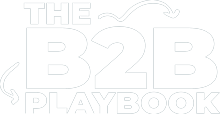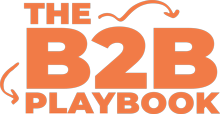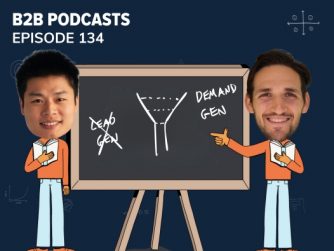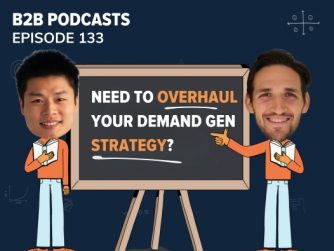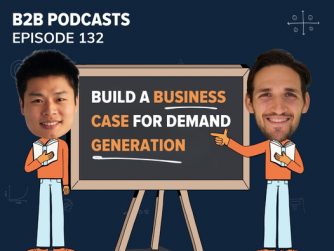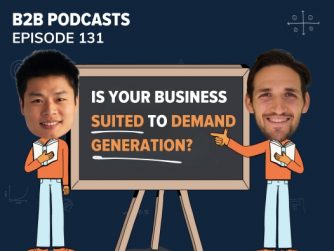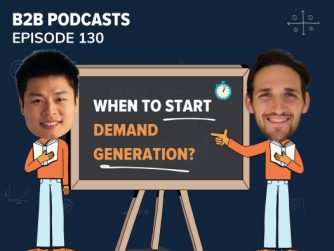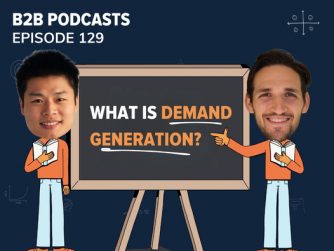One of the big reasons that so many demand generation programs fail is that the marketer doesn’t have the right frameworks to measure its success.
When you’re measuring demand generation, new programs should have different yardsticks to more mature programs that are 6-12 months in.
Of course, the dream is for every marketer to be reporting on revenue and showing that marketing is contributing to revenue. But if your demand generation program is focussed on creating demand rather than just capturing demand, then it’s going to take some time for that to happen.
This demand generation measurement framework is going to give you three tiers to reporting that help you shift from signs of life that your marketing is getting some traction, all the way to “this is clearly driving revenue.”
At a glance, the tiers of reporting will help tell the following story:
Tier 3: “There’s signs that our demand program is having an impact, but no pipeline or revenue yet. Stick to the program.”
Tier 2: “We can see some pipeline filtering through from our demand program. Great signs.”
Tier 1: “Marketing is clearly contributing revenue from this program. Carry on and scale it up.”
The goal for the marketer should be to start reporting at Tier 3 and then gradually make your way to Tier 1 as your marketing program matures.
Measuring Demand Generation: Tier 3 Reporting
When To Measure: Immediately
How Often To Look At It: Daily
Tier 3 demand generation measurements are what you’re looking to initially when you just launch a new demand generation campaign. Let’s say for example you’re launching an employee advocacy program, getting your subject matter experts, C-suites and evangelists to start regularly posting helpful material on LinkedIn.
You tier 3 measurements help us look for signs of life that this is having a positive impact on your market of Dream Customers. It’s our way of showing that – hey you might not have pipeline and revenue sourced from these activities in the first 90 days, but things are on the right track.
These channel level KPIs will vary depending on the channel that you’re using, but largely they should consist of the following.
Tier 3 – Quantitative Data
Quantitative data is the kind that tells you ‘what’ happened. It’s hard numbers that you’ll find in your analytics platforms like Google Analytics or within the reporting of your channel platforms themselves.
Great sources of quantitative data for demand generation include:
| Quantitative Data | Explanation |
| Collective views on a post for your company page | How many views did your company page posts on LinkedIn get from your ICP? |
| Collective views for your employees and Subject Matter Experts | How many views did your employees and Subject Matter Experts get from your ICP? |
| Engagement rates | Did your ICP click or interact with your social post? How far down your landing page did they scroll? |
| New followers of your company page or employee accounts from your ICP | Hint: use Phantombuster to pull new followers, and run analysis over companies and titles to see if they’re from your ICP |
| View which companies are seeing your LinkedIn posts | Hint: show LinkedIn analytics tools to do this |
| Amount of traffic visiting your website from your ICP | Hint: using traffic revealing software like Clearbit’s Free Weekly trial to do this |
Tier 3 – Qualitative Data
The qualitative data is that which is harder to reduce to numbers, but it’s some of the most valuable data you can surface. That’s because it tells you why or how something happened, not just what.
Great sources of qualitative data for demand generation include:
| Qualitative Data | Explanation |
| Are customers mentioning your content in their conversations with sales? | We often hear from our clients that the content we help them create is often mentioned by their customers as a key touchpoint |
| Are your employees or subject matter experts receiving DMs on LinkedIn about your content? | Content that strikes a chord with its audience will often receive feedback on social |
| Are your ICP commenting on your content? If so, what are they saying? | We find the best content often sees our ICP tagging each other in the comments section of the content to draw attention to it as a valuable resource. For example, in a piece of content designed to educate Legal Counsel about what they need to know when it comes to Modern Slavery, we have multiple Legal Counsel from our target segment tagging each other in the resource because it is simple helpful. |
Collecting qualitative data can be a challenge because it is so manual. We use a spreadsheet to manually input this data when we collect it. Otherwise you can just keep a repository of screenshots of these interactions that you can easily show to leadership.
Measuring Demand Generation: Tier 2 Reporting
When To Measure: Immediately
How Often To Look At It: Weekly
Tier 2 demand generation measurements are an early indicator to business results. As your demand gen program progresses you should start to measure and judge the success of your programs on this. This is marketing’s way of saying: “hey, we’re starting to see some meaningful contributions to pipeline.”
Tier 2 – Quantitative Data
Great sources of Tier 2 quantitative data for demand generation include:
| Quantitative Data | Explanation |
| HIRO Pipeline | HIRO stands for High Intent Revenue Opportunity, and you can define this how you like at your organisation. But it basically means a stage in your deal pipeline where Opportunities close at 25% or more, trailing 6 months. The goal is to increase the number of opportunities at this stage. It doesn’t have to be necessarily marketing sourced, because it can be difficult to measure demand creation programs. But we just want to make sure that the number of opportunities at this deal stage keeps increasing quarter over quarter. This is a great metric that aligns both marketing and sales, so the two are working together on creating as many high quality opportunities as possible. |
Tier 2 – Qualitative Data
Great sources of Tier 2 qualitative data for demand generation include:
| Qualitative Data | Explanation |
| Sales Feedback | This is feedback from sales to understand the quality of opportunities coming through. Ideally we want these to be improving |
| Getting feedback from buyers in market via sales | This is sales passing on any mention of your helpful demand programs like your podcast or webinar from an existing or potential client |
| Self-reported attribution | Self-reported attribution is simply asking your customer: “How Did You First Hear About Us’. Make this a mandatory, open text field. It forces your Dream Customers to recall the touchpoint that had the most impact on them. Often these are lost when you’re running programs that build great affinity with your Dream Customers but don’t necessarily lead them to ‘click’—> sign-up to your program – meaning that their impact is often lost or diminished when running analysis in your CRM. For example, we often have applicants of our demand gen program The B2B Incubator report to us they first heard it via our podcast, The B2B Playbook – or from me on LinkedIn organic. If you look in our CRM however, it will usually show the source is ‘Direct’ or ‘Organic’, which can be misleading and discount the work |
Tier 2 – Hybrid Attribution
You’ll want to use a combination of software attribution and self-reported attribution, but for different purposes. Software attribution (the kind of reports you’ll access in your CRM) are great for telling you how the demand was captured. I.e. at the point where your prospect in their long buying journey was finally ready to request a demo or contact your team, how did they do that?
Was it searching and clicking your Google or LinkedIn Ad? Was it a branded organic search? Did they just come to your website directly?
The goal here is to make sure you’re capturing that demand as efficiently as possible by improving things like your conversion rates on your landing pages, the precision of your ads targeting, and so on.
Self-reported attribution on the other hand can be a great way to tell you how that demand was created in the first place. In other words, how did your demand gen programs make your prospect aware of your brand, and build enough affinity with them until they become ready to buy from you? This is where we often see the success of our channels like our podcast, linkedIn organic activity and YouTube channel shine through. Even though they’re notably missing in our CRM report.
Measuring Demand Generation: Tier 1 Reporting
When To Measure: As program matures
How Often To Look At It: Quarterly
Tier 3 demand generation measurements is often Marketing’s KPIs, and is marketing’s way of saying that “we are accountable for revenue. We have a direct impact on the business.” This is a goal that every marketer should have with a mature demand gen program.
The three key KPIs to measure here is:
- website sourced pipeline and revenue
- customer acquisition cost
- pipeline velocity
Let’s get more into each of these.
Tier 1 – Website Sourced Pipeline & Revenue
For reasons we’ve explained here, measuring a marketing team on marketing sourced leads does not always make sense and can put the sales team in conflict with the marketing team.
As a general rule, the more simple and cheaper the product is you’re selling, the more ability marketing has to move a prospect from Dream Customer to opportunity. This means that measuring a marketer on the number of high intent hand raisers (e.g. demos booked) is a fair metric.
If however, the sales cycle is long, the product is complex and it’s expensive (e.g. packaging manufacturing) – there’s a good chance that sales are going to have to do some heavy lifting too. Your method for measurement here might be more in the way of marketing influenced pipeline than opportunities directly sourced through the website.
Tier 1 – Customer Acquisition Cost (CAC)
When calculating CAC, we like to take into account costs like advertising, tech spend and headcount. What you want to do is take the total revenue (or marketing sourced revenue) and divide it by these costs.
If we don’t take into account headcount in acquiring and servicing leads via sales, there’s a risk that you lose alignment with sales. Marketing’s CAC could decrease if they’re acquiring cheaper leads, but the cost to call those leads could increase if marketing is focussing on quantity over quality.
Check out our article here where we show you how we calculate our marketing CAC.
Tier 1 – Pipeline Velocity
Pipeline velocity measures how long it takes a business to move a customer through the sales funnel, or pipeline, from expressed need to conversion. Pipeline velocity grows when more customers buy more, faster.
This is an important metric because it ensures our marketing efforts are aligned on quality, not just quantity. Quality means that we care about what happens to a deal, not just whether or not an MQL was sourced.
Want To Help Putting This Report Together?
If you need help putting your 3 tiered demand generation report together, that’s something we can give you a hand with! Simply send us a message right here, and we’ll get back to you shortly.
Need To Drive More Demand For Your Business?
If you need to put in place a demand generation engine for your business, we give you the strategy, templates and tools in our 12 week program The B2B Incubator.
Not quite ready for a paid program? We give away our 5 BEs Framework for demand generation every week on The B2B Playbook podcast. See below how you can follow along!
Create Your Demand Engine in 12 Weeks
B2B marketing strategy that shows you step-by-step how to drive revenue
